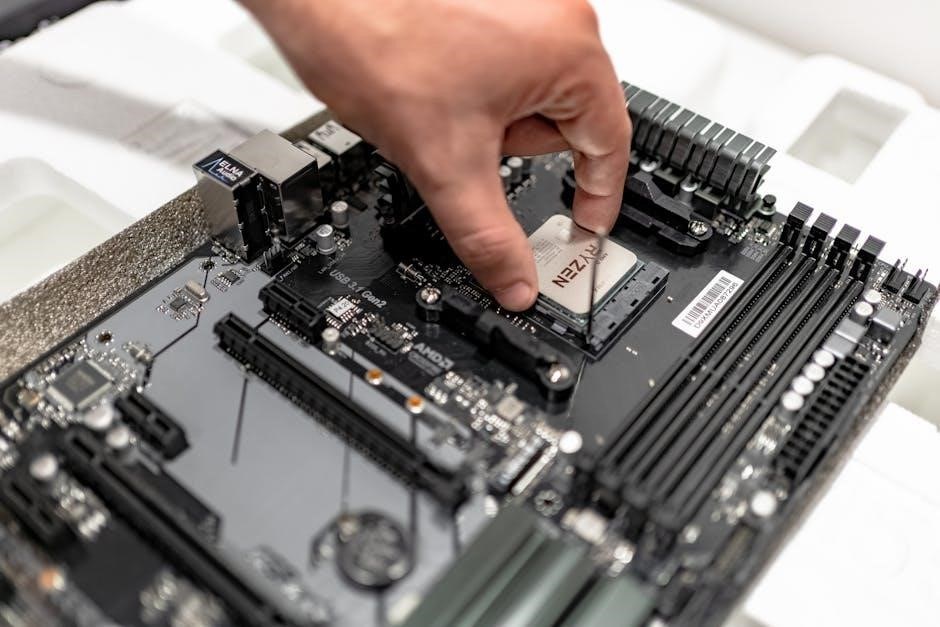System Sensor Smoke Detector Manual: A Comprehensive Guide

This comprehensive guide delves into the intricacies of System Sensor smoke detectors. It emphasizes the importance of thoroughly understanding the provided manuals for proper usage. The guide highlights key aspects like spacing, placement, wiring, zoning, and applications. This ensures optimal functionality of the smoke detectors within fire alarm systems.

System Sensor smoke detectors are crucial components of modern fire alarm systems, designed for rapid and reliable smoke detection. These detectors come in various models, including two-wire and four-wire configurations, catering to diverse installation needs. System Sensor offers a comprehensive range of detectors, including ionization and photoelectric types, each with unique sensing capabilities. The manuals provided by System Sensor are vital resources, offering detailed information on proper installation, maintenance, and troubleshooting. These manuals emphasize the importance of adhering to NFPA 72 standards for optimal performance and safety. Understanding the specific features and functionalities of each System Sensor model is essential for ensuring effective fire protection. They provide detailed instructions on spacing, placement, wiring, zoning, and special applications. System Sensor smoke detectors are marked with compatibility identifiers. These identifiers are located on the product labels. These identifiers help ensure compatibility with alarm control panels. Proper installation and maintenance are key to ensuring the detector’s life and performance. Regular testing and cleaning are necessary to maintain sensitivity.

Understanding the Manual: Key Sections and Information
The System Sensor smoke detector manual is a vital resource for installers, maintenance personnel, and end-users. It is structured to provide clear and concise information about the detector’s operation and maintenance. Key sections typically include installation guidelines, wiring diagrams, testing procedures, and troubleshooting tips. The manual provides details on detector spacing, placement considerations, and zoning configurations. Wiring diagrams illustrate proper connections for different models, including two-wire and four-wire systems. Compatibility charts are often included to ensure seamless integration with various alarm control panels. Maintenance sections outline recommended cleaning schedules and testing methods. Troubleshooting guides address common issues such as false alarms and detector malfunctions. The manual emphasizes adherence to NFPA 72 standards for fire alarm systems. It provides essential information for ensuring reliable and effective smoke detection; Understanding the manual’s key sections is crucial for proper installation and maintenance. It allows users to maximize the detector’s performance and lifespan. The manual also includes information on special applications and considerations. The manual should be left with the owner/user of the equipment.

Installation Guidelines: Spacing, Placement, and Wiring
Proper installation is paramount for the effectiveness of System Sensor smoke detectors. The installation manual provides detailed guidelines regarding spacing, placement, and wiring. Spacing requirements vary depending on the specific model and the area being protected. It is crucial to adhere to these guidelines to ensure adequate smoke detection coverage. Placement considerations involve avoiding areas with excessive dust, drafts, or humidity. Detectors should be mounted on ceilings or walls following the manufacturer’s instructions. Correct wiring is essential for proper operation and compatibility with the alarm control panel. Wiring diagrams in the manual illustrate the correct connections for different models and system configurations. For two-wire detectors, compatibility charts are crucial for selecting compatible alarm control panels. Four-wire detectors often require separate power and signal circuits. The manual emphasizes the importance of using the correct wire gauge and making secure connections. It is essential to follow all applicable electrical codes and safety regulations. Incorrect wiring can lead to malfunctions, false alarms, or failure to detect smoke. The manual provides step-by-step instructions for installing the detector. Prior to installation, it is recommended to read the System Sensor manual. Proper installation ensures the reliability and effectiveness of the smoke detector. It is key to fire safety.
Maintenance and Testing Procedures
Regular maintenance and testing are crucial for ensuring the continued reliability of System Sensor smoke detectors. The maintenance section of the manual outlines recommended procedures for cleaning, inspecting, and testing the detectors. Detectors should be cleaned at least once a year to remove dust and debris that can interfere with their operation. Use a vacuum cleaner with a soft brush attachment to gently clean the exterior of the detector. Avoid using liquids or cleaning agents, as they can damage the internal components. Periodic testing is necessary to verify that the detector is functioning correctly. The manual describes various testing methods, including the use of test modules or canned smoke. The MOD400R Test Module can be used to test the sensitivity of certain System Sensor models. When testing, ensure that the alarm signal is received by the control panel. Inspect the detector for any signs of damage or corrosion. Check the wiring connections to ensure they are secure. Replace any damaged or worn components. The manual also provides guidance on battery replacement for models with backup batteries. Follow the manufacturer’s instructions for proper battery type and installation. Regular maintenance and testing can help to identify potential problems before they lead to a failure. Adhering to the recommended maintenance schedule ensures that the smoke detectors are always ready to protect lives and property.
Troubleshooting Common Issues
The troubleshooting section of the System Sensor smoke detector manual addresses common issues encountered during operation. False alarms are a frequent concern, often caused by dust, insects, or environmental factors. The manual advises regular cleaning to minimize dust accumulation and provides tips for identifying and eliminating sources of interference. If a detector fails to activate during a test, the manual suggests checking the power supply, wiring connections, and detector sensitivity settings. Incompatibility with the control panel can also cause malfunctions. The manual includes a compatibility chart to ensure proper matching of detectors and panels, particularly for two-wire models. For two-wire detectors, ensure compatibility by consulting the System Sensor compatibility chart available online. The LED indicator on the detector can provide valuable diagnostic information. A steady or flashing LED pattern may indicate a specific problem, such as a low battery, maintenance requirement, or alarm condition. The manual explains the meaning of different LED patterns and corresponding troubleshooting steps. If a detector drifts out of its sensitivity limits, the LED may cease to blink, indicating that maintenance is required. Faulty wiring can also lead to operational problems. Inspect the wiring for loose connections, corrosion, or damage. Follow the wiring diagrams in the manual to ensure correct installation. When troubleshooting, always refer to the manual for detailed instructions and safety precautions.
Compatibility and Wiring Diagrams for Different Models
Understanding the compatibility of System Sensor smoke detectors with various alarm control panels is crucial for proper system operation. The manual provides detailed compatibility charts, especially important for two-wire models like the 2WTR-B and 2WTA-B, which require specific compatible panels. Always consult the System Sensor website or the manual to verify compatibility before installation. Wiring diagrams are essential for correctly connecting detectors to the alarm system. The manual includes diagrams for different models, illustrating how to connect power, signal, and remote annunciator wires. For instance, the wiring diagram for the 2100 and 2100T models shows the proper placement of the end-of-line resistor. These diagrams also detail optional Class A wiring configurations. The compatibility identifier, located on the back of the detector, is a key reference. System Sensor two-wire smoke detectors have this identifier to help confirm compatibility with listed alarm control panels. When using the RA400Z Remote Annunciator, ensure it operates within the specified detector alarm currents. Different models may have unique wiring requirements, so always consult the appropriate diagram for your specific detector. Two-wire systems use the same two wires for power and zone circuits, while four-wire systems have separate circuits. The diagrams clearly illustrate these differences. Correct wiring ensures reliable alarm transmission and prevents false alarms or system failures. Before wiring, always remove power from the alarm system to prevent electrical shock. If unsure about the wiring, consult a qualified electrician or fire alarm technician.
Special Applications and Zoning Considerations
System Sensor smoke detectors can be used in various special applications, requiring careful consideration of zoning and placement. The manual provides guidance on these applications, including duct smoke detection and interconnected systems. For duct smoke detectors, refer to System Sensor’s Applications Guide (HVAG53), which offers information on spacing, placement, and wiring specific to HVAC systems. Proper zoning is crucial for identifying the location of a fire quickly. The manual outlines considerations for zoning, ensuring that each zone covers a defined area. Interconnected systems allow multiple detectors to communicate, triggering all alarms upon detecting smoke in one location. When interconnecting smoke alarms, follow the manual’s instructions for wiring the signal (SIG) terminals. Special applications may also include areas with unique environmental conditions, such as high humidity or temperature extremes. The manual specifies the operating temperature and humidity ranges for different models. In areas with potential for false alarms, such as kitchens or bathrooms, consider using detectors with built-in heat sensors, like the 2WT-B model. Zoning should also take into account the building’s layout and occupancy. The manual provides recommendations for detector spacing based on NFPA 72 standards. For large or complex buildings, consult a fire protection engineer to ensure proper zoning and detector placement. Always refer to local codes and regulations for specific requirements related to special applications and zoning. Proper planning and adherence to the manual’s guidelines are essential for effective fire detection and alarm response.
Two-Wire vs. Four-Wire System Sensor Smoke Detectors
System Sensor offers both two-wire and four-wire smoke detectors, each with distinct wiring configurations and compatibility requirements. Two-wire detectors, like the 2W-B and 2WT-B models, transmit power and alarm signals through the same two wires. This simplifies wiring but necessitates compatibility with the alarm control panel. The System Sensor compatibility chart, available on their website, identifies compatible panels for two-wire models. Four-wire detectors, such as the 4W-B and 4WT-B, have separate wires for power and alarm signals. This allows for greater flexibility in wiring and compatibility with a wider range of control panels. However, four-wire systems require more wiring than two-wire systems. When connecting two-wire detectors, ensure the control panel limits the alarm current to 100 mA maximum. Some models, like the 2WT-B, include a built-in heat sensor for enhanced fire detection. For two-wire models 2WTR-B and 2WTA-B, connect detectors only to compatible alarm control panels. System Sensor two-wire smoke detectors are marked with a compatibility identifier on the label. The manual provides wiring diagrams for both two-wire and four-wire detectors. It’s essential to follow these diagrams carefully to ensure correct installation. The choice between two-wire and four-wire systems depends on the specific application, control panel capabilities, and wiring preferences. Always consult the manual and compatibility charts before installing any System Sensor smoke detector.
Where to Find System Sensor Manuals and Resources
Accessing System Sensor manuals and resources is crucial for the correct installation, maintenance, and troubleshooting of their smoke detectors; The primary source for these documents is the System Sensor website, www.systemsensor.com. Here, you can find a comprehensive library of manuals, data sheets, application guides, and compatibility charts. Specifically, look for manuals like I56-407, “Guide for Proper Use of System Smoke Detectors,” which provides detailed information on spacing, placement, zoning, and wiring. The “Applications Guide for System Smoke Detectors” (A05-1003) and “Applications Guide for Duct Smoke Detectors” (HVAG53) offer specialized guidance. For two-wire detector compatibility, consult the System Sensor compatibility chart available online. In addition to the website, manuals may also be included with the purchased smoke detector. It’s vital to retain these physical copies for easy reference. ManualsLib.com may also host some System Sensor manuals. Remember to always verify the information with the official System Sensor website. For technical assistance, contact System Sensor directly via their website or customer service line (1-800-SENSOR2). When seeking information, provide the specific model number of your smoke detector to ensure you receive the correct documentation. Properly utilizing these resources ensures the optimal performance and longevity of your System Sensor smoke detection system.
